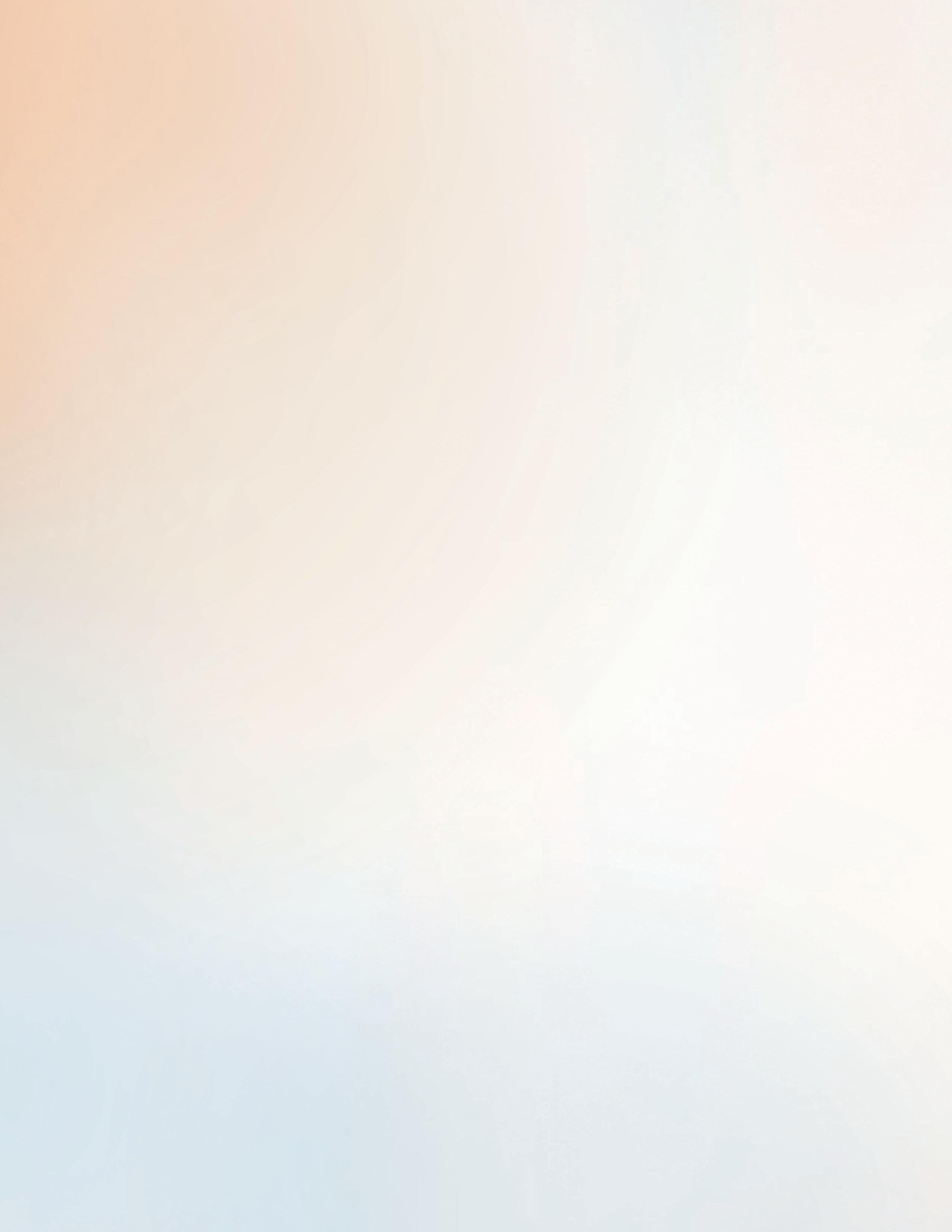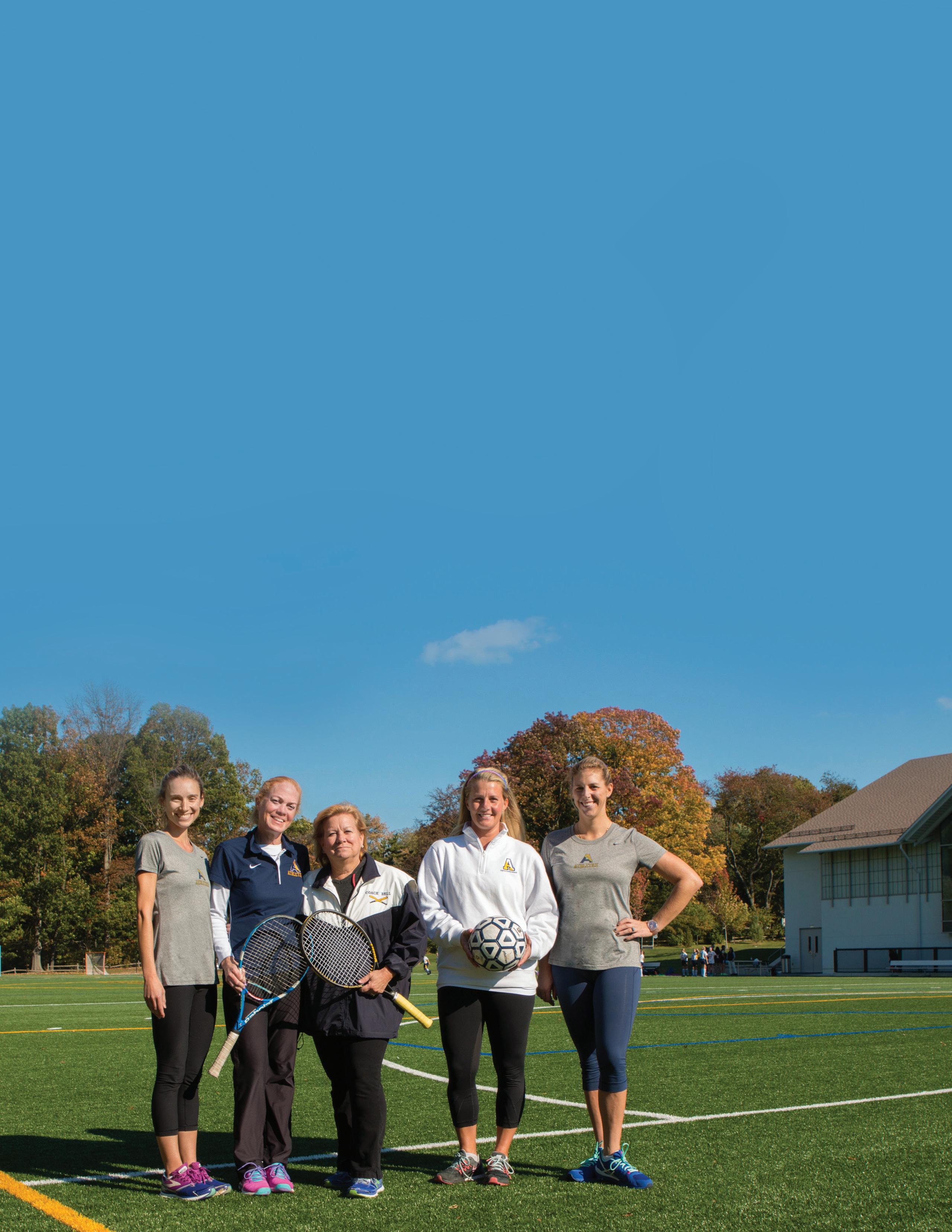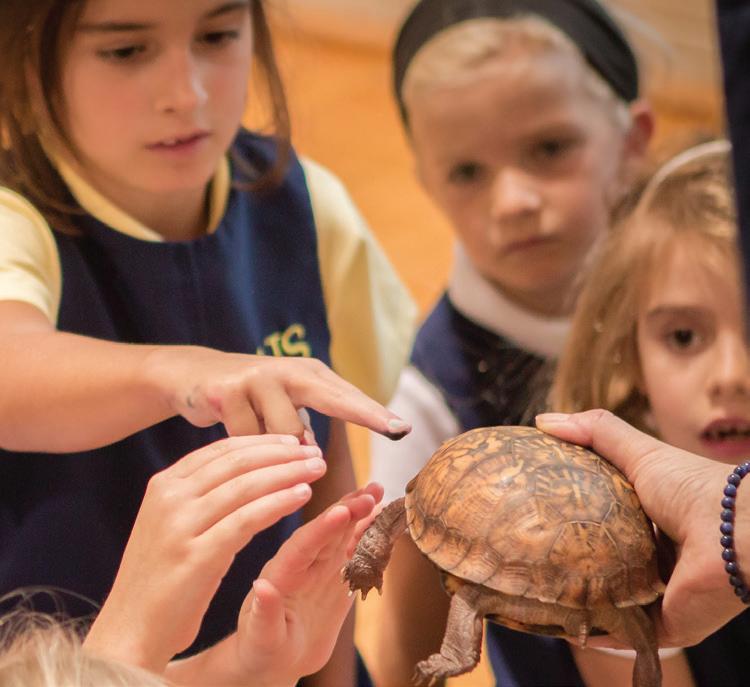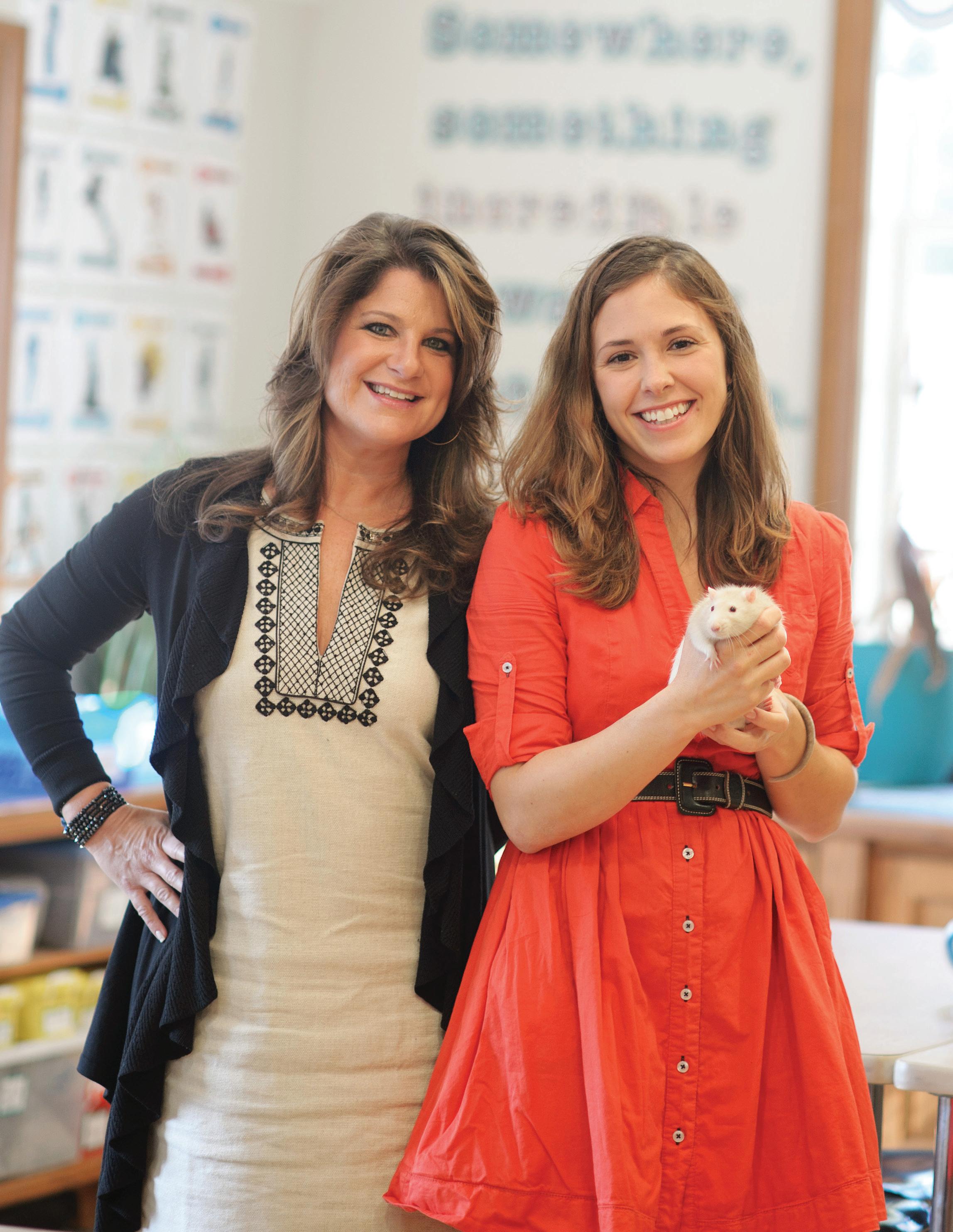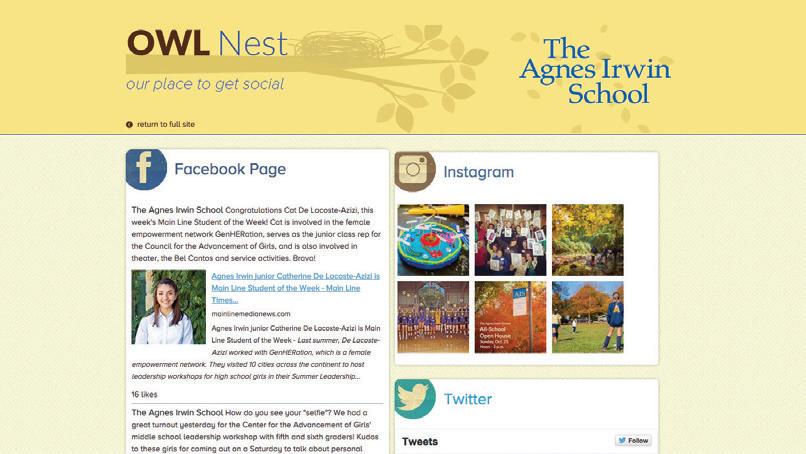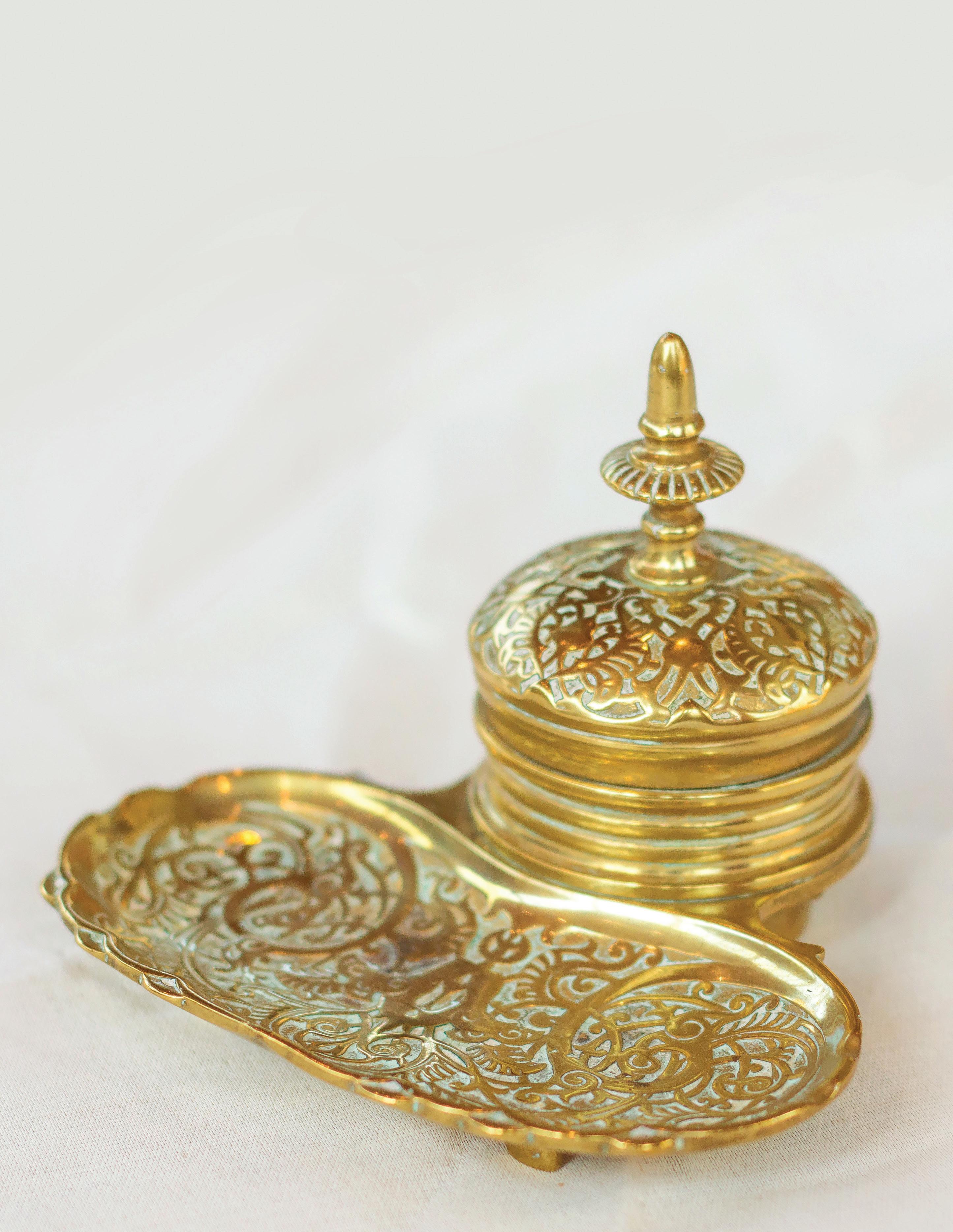
26 minute read
Timeline
ON CAMPUS Living Art
Inspired by Dr. Jane Goodall and her scientific work, art teacher Terri Frock designed and built three chimpanzee topiaries that were installed on campus in September. “My motivation was to find something that had the possibility of activating the community to participate and have a positive impact on the environment,” said the sculptor, who is devoted to tending to her own chunk of green space in Philadelphia. When, at the end of last school year, Arts Department Chair Bill Esher asked the visual arts faculty to add a component to the curriculum that would get students excited about Dr. Goodall’s Sept. 15 visit, “topiary sculptures … seemed like an opportunity to create an installation that could become a pollinator wonderland,” Frock said.
Advertisement
— Amanda Mahnke
MARCH
Visual arts staff were asked to brainstorm student projects inspiring “Hope for Humankind,” Agnes Irwin’s theme for the next school year. Frock initially considered creating a sculpture from recycled materials, but decided that topiaries — which could serve as the centerpiece in a pollinator-friendly garden — better fit with her interpretation of Dr. Goodall’s message of “Sowing the Seeds of Hope.”
APRIL
After spring break, Middle School students from Kathy Halton, Keri Farrow and Frock’s classes examined the work of sculptor Antony Gormley. His project Field was a collaborative experiment that focused on creating art from the earth, through clay. Students sculpted, then painted, chimpanzees; they also discussed the fact that everyone is responsible for the health of the earth and the environment. The chimpanzee sculptures were later included in the topiary display.
JUNE
Frock conducted a good deal of research regarding the anatomy of chimpanzees, drawing from trips to the zoo, the library, the Academy of Natural Sciences and Internet research. She also relied heavily on the faculty’s summer reading assignment, Goodall’s autobiography In the Shadow of Man — which had great photo references. “I was most touched by how she described the chimps,” Frock said, citing a passage where Goodall describes how the chimps would sit in the rain, hunched over.
For more info visit AGNESIRWIN.ORG
JUNE TO SEPTEMBER
Frock used chicken wire leftover from her home renovation and a few new rolls from Home Depot to create the topiary armature. “I approached them like a normal work day, dividing the time between research and building through trial and error,” Frock said. “I learned a good bit about anatomy and how to build something that would be able to support the weight of a material dry and wet.”
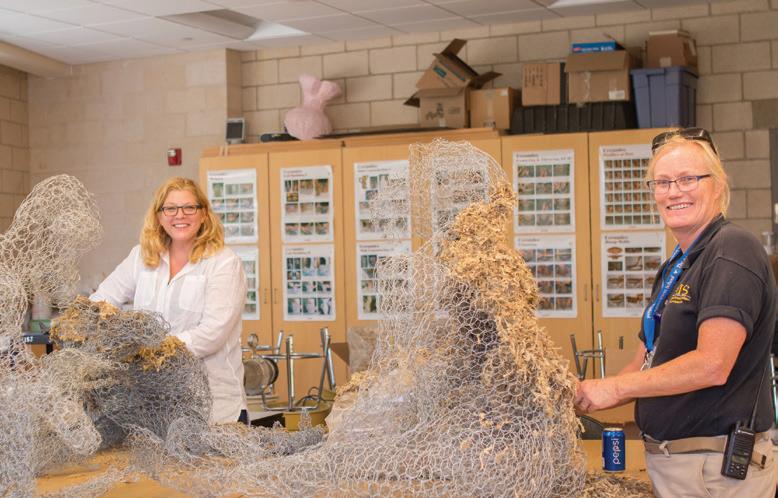
AUGUST
Frock transported the chimpanzee sculptures to the school and with groundskeeper Patricia Mangine began the process of stuffing the chimps with sphagnum moss, commonly used for topiaries. The process took about eight days and utilized 100 pounds of moss. Pieces of sedum from the school’s green roof, as well as ivy, were also added.
SEPTEMBER 15
Frock had the opportunity to show the topiaries to Dr. Jane Goodall during a tour of campus. “We talked about how important pollinator gardens are to cultivate,” Frock said. “She felt we could never have enough places for wildflowers to grow.”
SEPTEMBER 10
Facilities staff helped to move the topiaries to a prominent place in the Hamilton Family Courtyard and Dining Terrace for Dr. Goodall’s visit. Frock added pots of flowers and students’ chimpanzee sculptures. “Ideally, my hope is that they could be installed somewhere a bit more intimate than where they are now, sitting in the midst of a super-pollinator garden somewhere on campus,” she said. “I am beginning to work with facilities and the science department on some ideas to make that happen.”
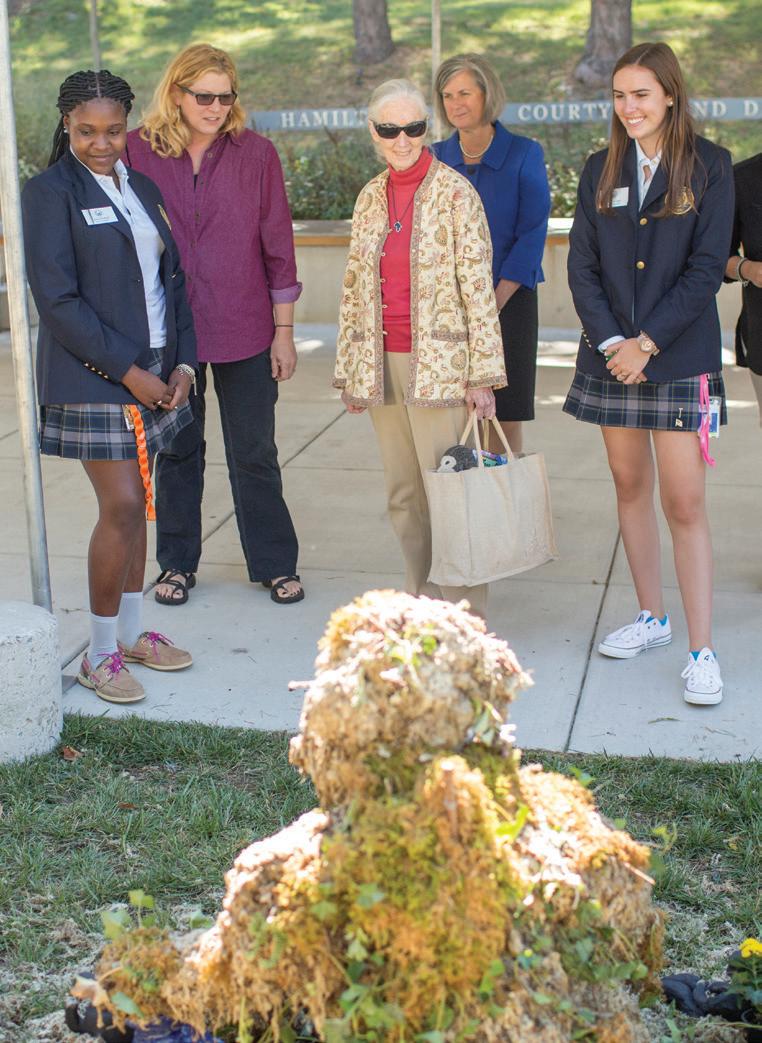
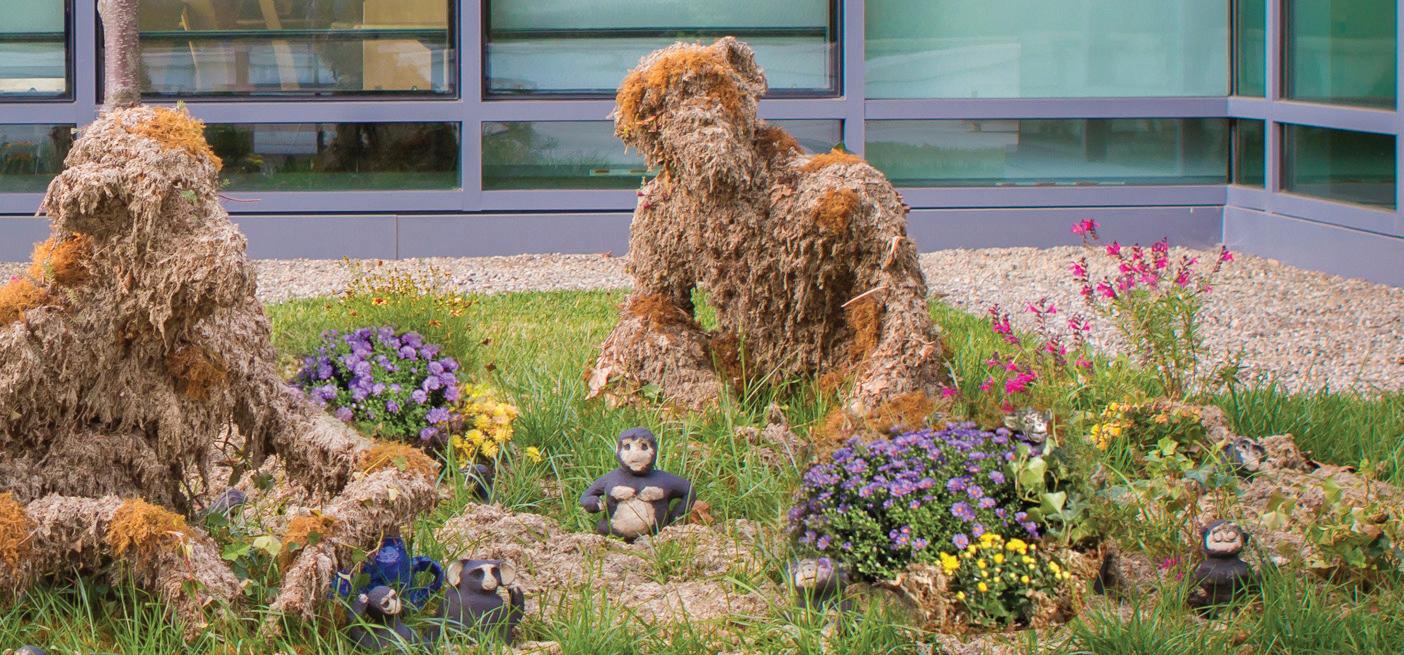
Cultivating HOPE
Dr. Jane Goodall Shares Her Life with Nature
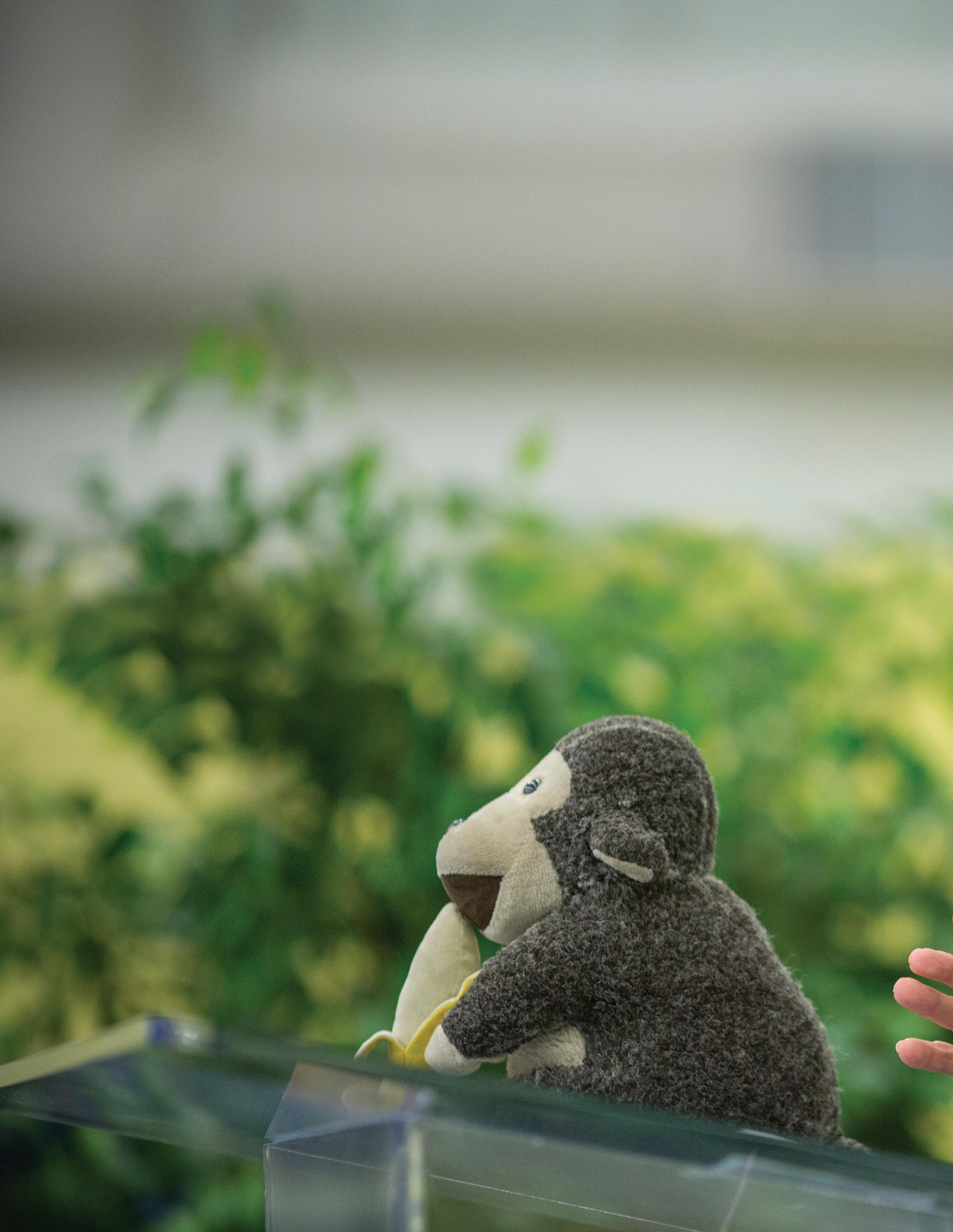
by Amanda Mahnke
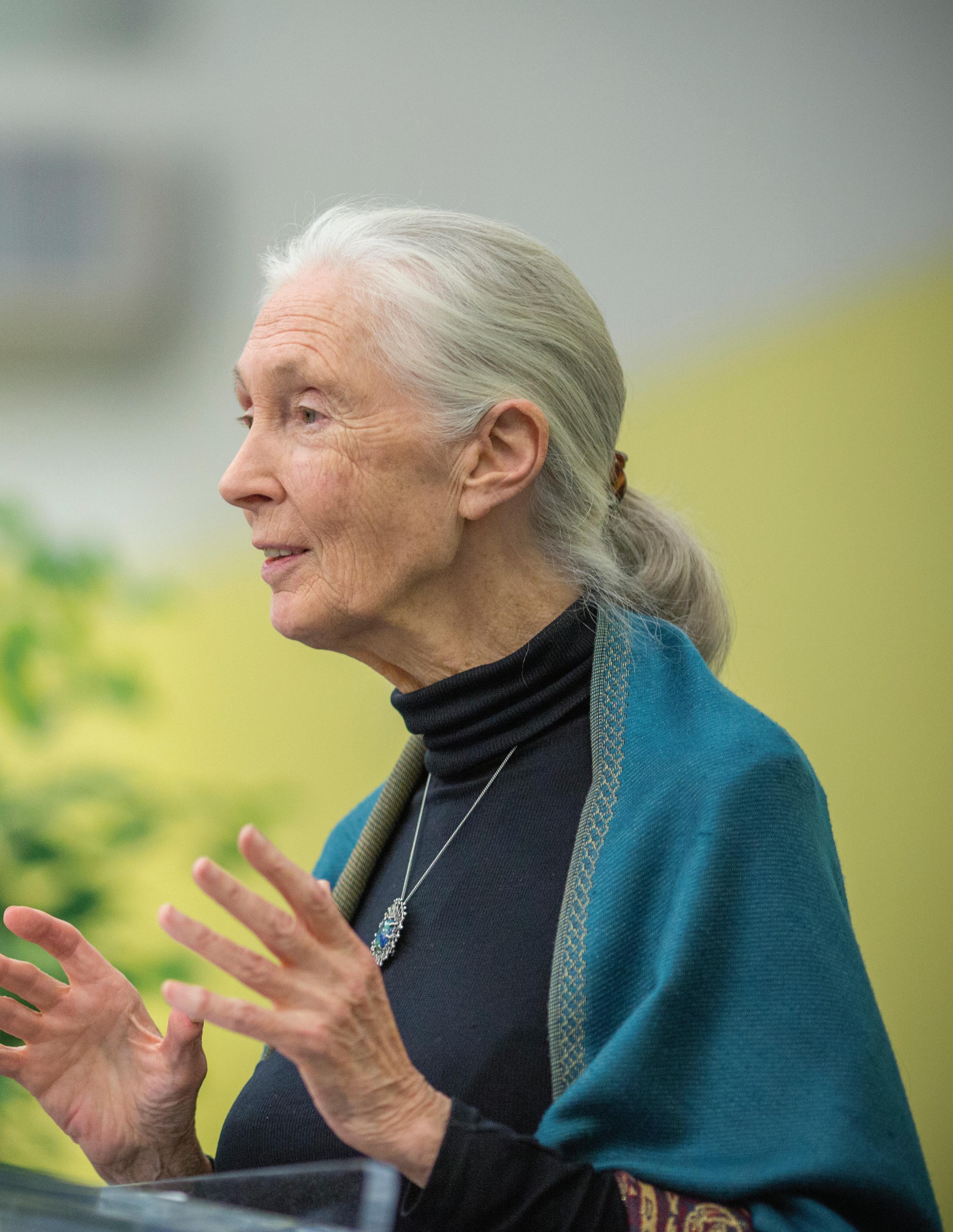
Adorned in khaki and outfitted with binoculars and stuffed chimpanzees, fifth graders Noelle Birdsall, Nina Kirkpatrick and Lily Halpert all spent one day last January living the life of world-renowned primatologist and conservationist Dr. Jane Goodall. Reciting the researcher’s life accomplishments in the Laura Thomas Buck ’49 Pavilion during the fourth grade’s annual Women in Wax Museum, they had no idea that 10 months later, in the very same room, they would be meeting their hero in the flesh.
Describing the girls as “excited” when they found out would be a gigantic understatement.
“I wanted to shout it from the rooftops!” exclaimed Noelle.
Goodall, universally known for her landmark study on the behavior of wild chimpanzees in Gombe National Park in Tanzania 55 years ago, brought her message of hope and environmental stewardship to The Agnes Irwin School on Sept. 15, charging students and families with making a difference in the world around them.
A United Nations Messenger of Peace, Goodall began her research in 1960 at the age of 26, a remarkable and daring endeavor for a young woman during those times. Considered the world’s foremost expert on chimpanzees, she is the founder of the Jane Goodall Institute, a global nonprofit that seeks to contribute to the understanding and preservation of great apes and their habitats through conservation, research and education.
Head of School Dr. Wendy Hill met Goodall several years ago when the researcher visited Lafayette College, where Dr. Hill served as provost. “Her way of inspiring young people to follow their dreams is so powerful,” Dr. Hill said. “We wanted to bring that energy here to Agnes Irwin and give our girls an especially strong example of how to lead — despite any obstacles that may stand in their way.”
The 81-year-old travels more than 300 days a year, sharing her message of environmentalism with audiences across the world. Agnes Irwin marked the first stop on her Fall 2015 United States lecture tour.
On Sept. 15, Goodall met with Lower and Middle School students in morning assemblies, sharing stories about her life living among chimpanzees and speaking to students about the Jane Goodall Insti-
Below: Lower School students created several murals in advance of Goodall’s visit. Right: “How many of you love animals?” Goodall asked Lower School students in a morning presentation on Sept. 15.
DR. WENDY L. HILL

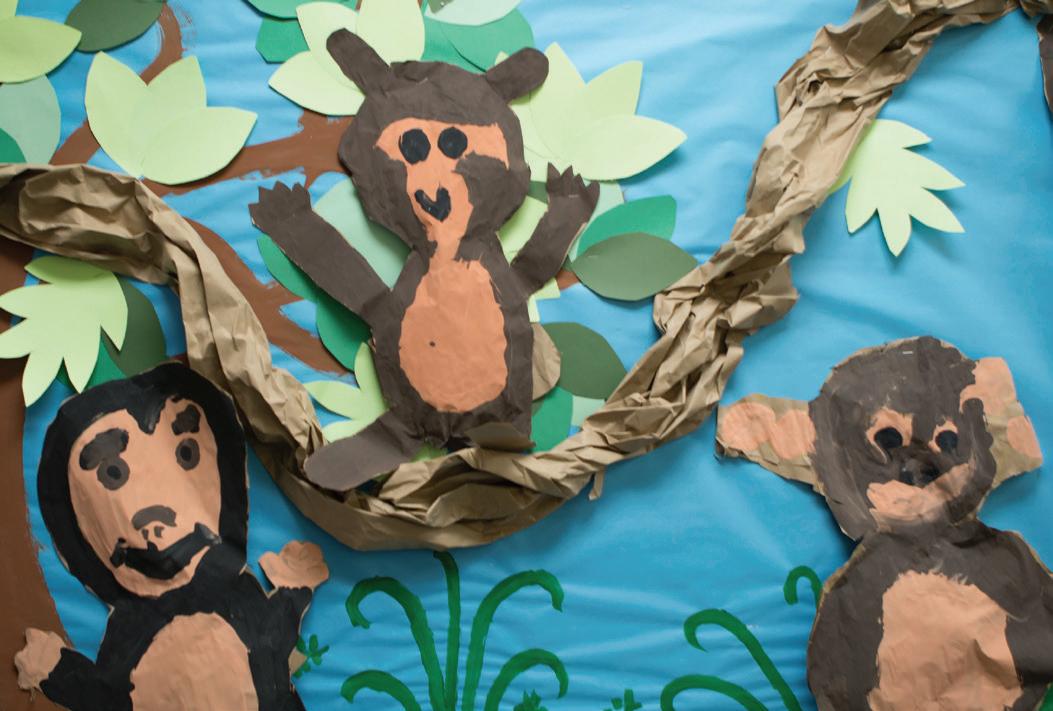
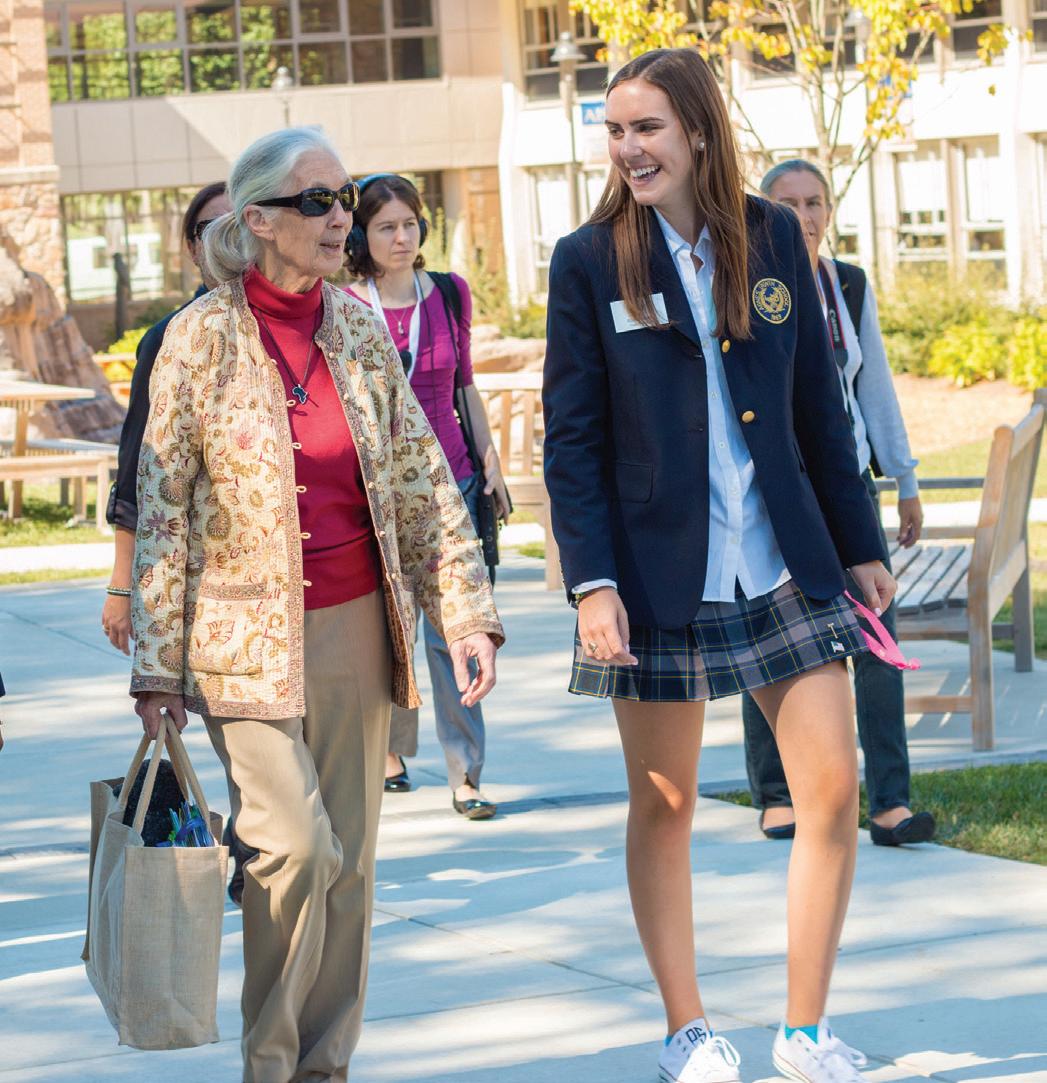
Left: Head Tour Guide Riley Powers ’17 chats with Goodall during a tour of campus she led with Jaakirah Reid ’16. Below: Fifth graders Lily Halpert, Nina Kirkpatrick and Noelle Birdsall greet Goodall before escorting her to the Middle School assembly.
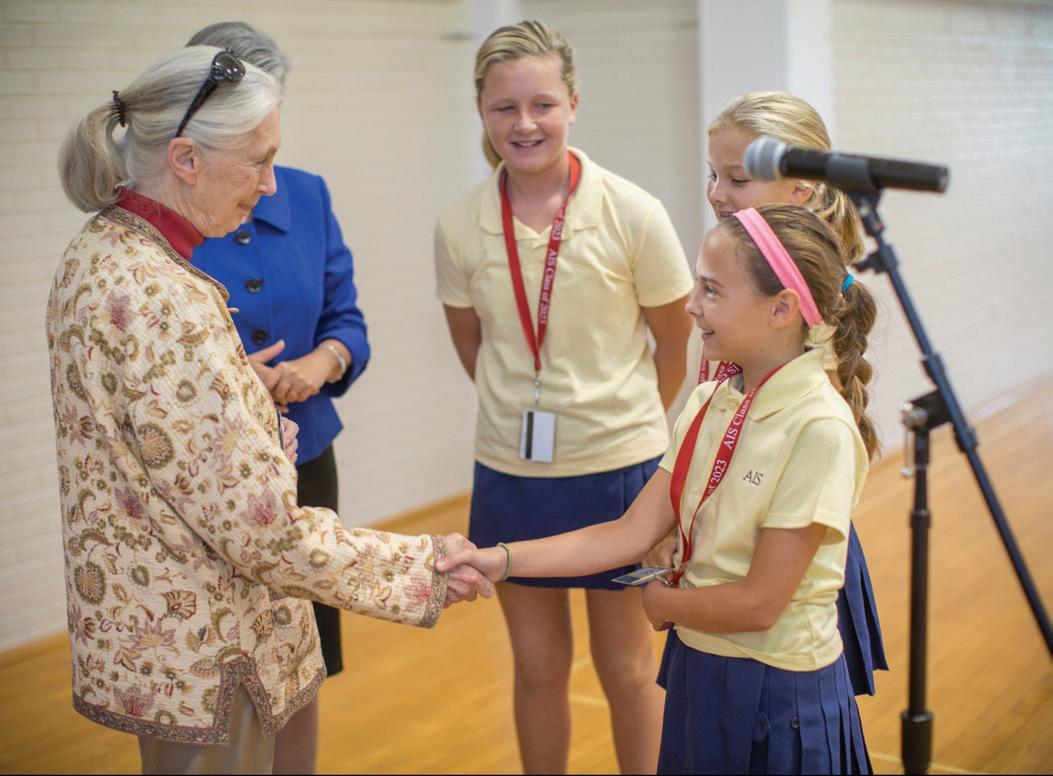
tute’s youth-led community action program Roots & Shoots. In the evening, she spoke to Upper School students, faculty and staff, AIS families and guests in a lecture entitled Sowing the Seeds of Hope.
The school began preparing for Goodall’s visit long in advance of Sept. 15. In the spring, faculty members were asked to think about how they might incorporate messages of conservation and environmental care into their curriculum the coming year. Over the summer, staff and Upper School students read Goodall’s memoir In the Shadow of Man; Middle School read My Life Among the Chimpanzees; and Lower School read the picture book Me, Jane.
Art projects were begun in earnest, including art teacher Terri Frock’s set of three topiary chimpanzees, which were prominently displayed in the courtyard during Goodall’s visit. Lower School students and art teacher Trish Siembora created a series of vibrant
DONNA LINDNER
murals — of chimpanzees swinging among the trees, colorful fish swimming in the ocean, and farm animals in pasture, studded with several quotes on conservation — that were displayed prominently in the Owl Lobby.
Arriving just after the start of the school day on Sept. 15, Goodall was greeted outside the Lower School by Dr. Hill. As she entered the mural-adorned Owl Lobby, carrying her world-traveling stuffed monkey Mr. H, fourth graders Dakota and Sydney Puriefoy welcomed her with the stuffed chimpanzees of fourth grade teacher Pedie Hill. All three entered the Buck Pavilion to the sounds of the entire Lower School singing the whimsical “Walking in the Air” by Howard Blake, one of Goodall’s favorite songs.
Goodall began her presentation to Lower School students by imitating a chimpanzee’s “good morning” call, then calling up second grader Annabel deForest Keys to help her demonstrate other ways a chimpanzee communicates. She also shared with students several stories from her time overseas, and the advice her mother gave her when the young Jane decided she wanted to go to Africa and live among the animals: “If you really want to do something, you must work very hard and never give up.”
The visit brought to life many of the lessons girls are taught in the Lower School, said Donna Lindner, Lower School Director. “Everything we do, everything we teach in the Lower School happens through the lens of leadership,” she said. “Our students learn that even as young girls, they have the capacity to lead by staying true to their independent-minded, resilient, problem-solving selves. Dr. Goodall’s story and her time with our girls brought that truth to life for our Lower Schoolers. The words were no longer words: They were personified in the woman standing in front of them.”
In both the Lower School and Middle School assemblies, the researcher encouraged students to remember their own effects on the surrounding environment.
“Everybody in this room has an impact. Will you make the world a better place? How will you treat animals? Other humans? The envi
DR. JANE GOODALL
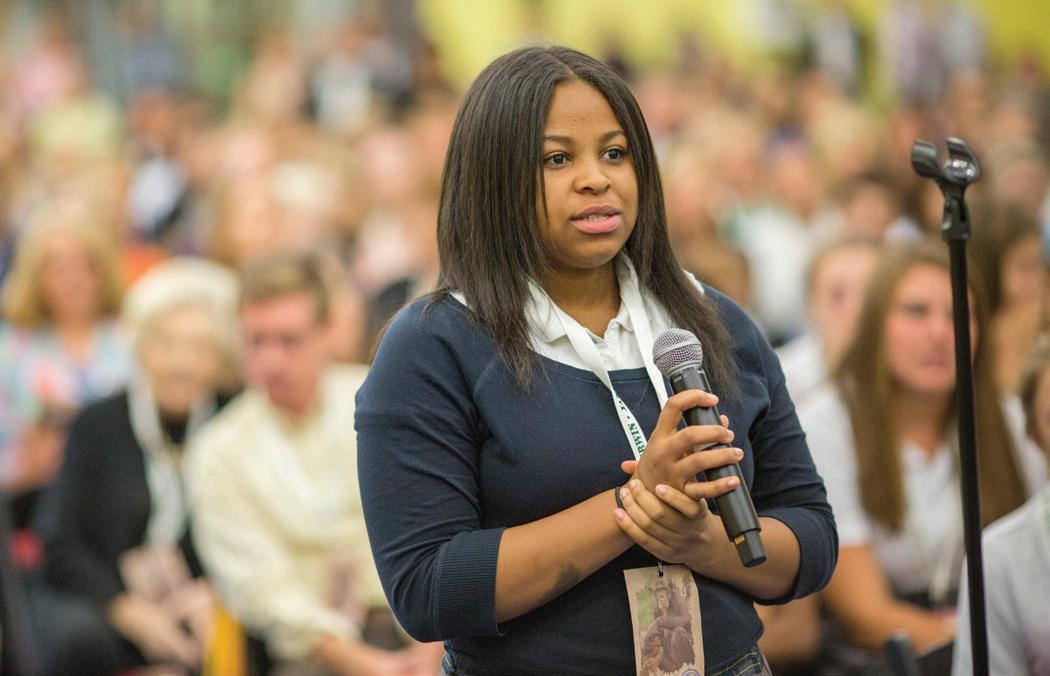
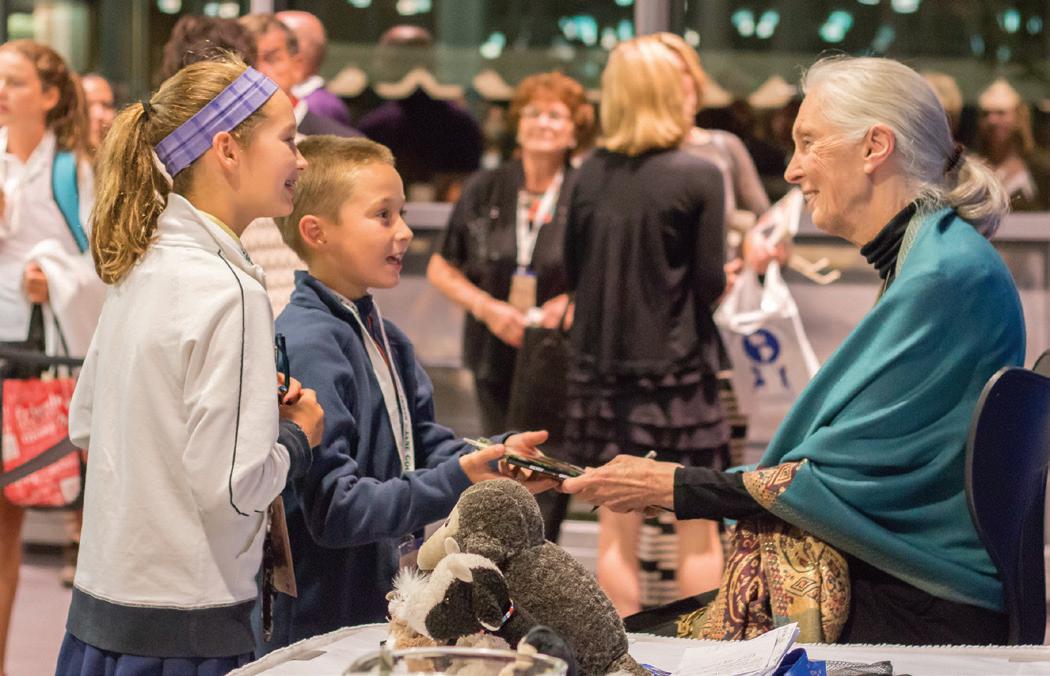
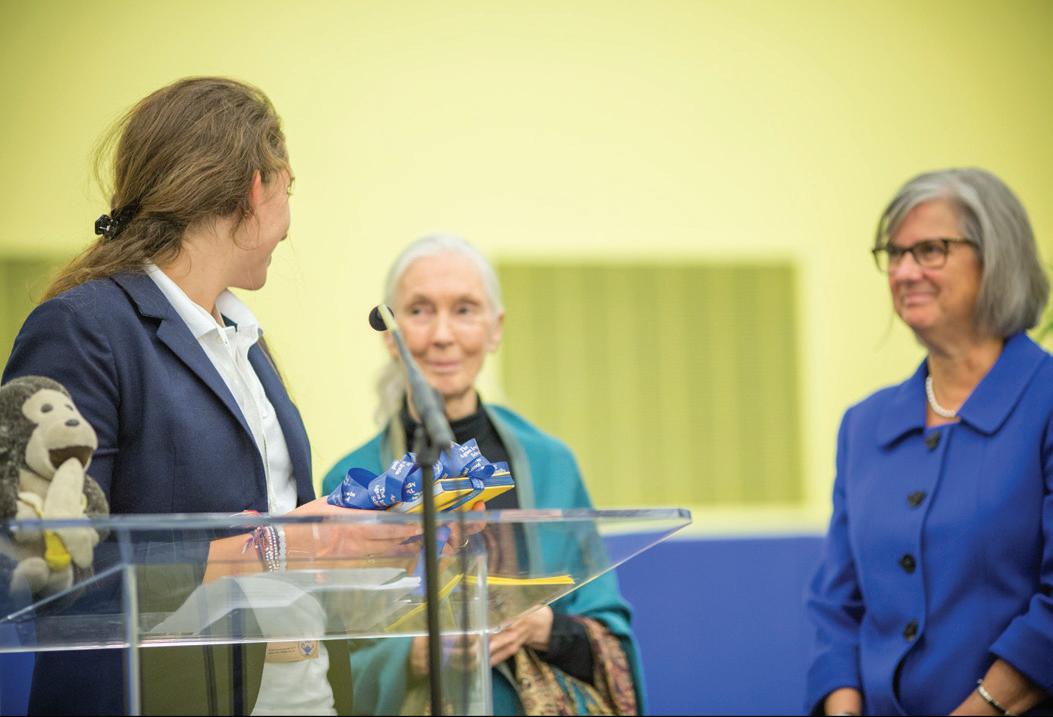
ronment?” Goodall asked Middle School students. “Don’t forget that you matter.”
A significant portion of the Middle School assembly, held in the West-Wike Theatre, was devoted to a question-and-answer session. Students posed a variety of insightful questions, including how Goodall balanced caring for animals and caring for humans, especially at times when those desires appear to conflict.
“Unless we help people to improve their lives in environmentally sustainable ways, we can’t help the chimpanzees,” Goodall answered.
Head tour guides Jaakirah Reid ’16 and Riley Powers ’17 led Goodall on a tour of campus after her talk with the Middle School, in what both agreed was one of the highlights of their high school career.
“It was a surreal experience to meet Dr. Goodall,” Riley said. “After learning and hearing so much about her, it was amazing to be able to host her on our own campus. She is a woman who found her passion and pursued it. She was not held back or intimidated by the fact that nobody had done what she was trying to do before — she paved the way for it all.”
Goodall shared more about her life work at an evening lecture in the school’s main gymnasium, where more than a thousand members of the Agnes Irwin community, including Upper School students and Agnes Irwin families, gathered to hear her presentation.
For the past three decades, Goodall has spent more time on the lecture circuit than studying chimpanzees on the plains of Africa — and that’s an intentional choice, she told those seated in the packed gymnasium. The switch came following a conference she attended in 1986 where she learned about widespread deforestation, the animal trade and other practices rapidly destroying the environment.
“It was shocking,” she recalled. “I went to the conference as a scientist and left an activist. I didn’t know what to do, but I knew I had to do something.”
Through the Jane Goodall Institute and her outreach efforts as a United Nations Messenger of Peace, the researcher hopes to inspire others to consider their own impact and what efforts they can take to help protect the world for future generations.
Referencing climate change, deforestation and violence, Goodall told students, “We have compromised your future. But is it true that it’s too late to change things? I don’t think so.”
Goodall shared and expounded upon her reasons for hope in the face of a world filled with bad news, trusting in the power of the human brain, resiliency of nature, power of social media, the indomitable human spirit and the determination of young people.
“My greatest hope is in … young people who see the problems in the world and are inspired to take action,” Goodall said.
That message of conservation and care for living creatures has also inspired Agnes Irwin’s yearlong theme of “Hope for Humankind.” Through academic and co-curricular activities, the school hopes to reflect on the mission and essence of Dr. Goodall’s decades-long work as a conservationist and humanitarian.
The threads of that theme are woven throughout the fabric of the
Top: Kaylah Artis ’19 was among a dozen students who lined up for the question-and-answer portion of the lecture. Middle: Kate McNulty ’21 and her brother stayed for the postlecture book signing. Bottom: Student Body President Katherine Pew presents Goodall with a book of student art inspired by the primatologist’s life work.
RILEY POWERS ’17
school year, throughout divisions and disciplines. Jenny Hoffman’s AP Environmental Science class, for example, will study biodiversity in November, showing the film Virunga about the impact of resource extraction on mountain gorillas in the Democratic Republic of Congo. Mary Higgins’s international relations class will be undertaking a unit on climate change, including a simulation in which students will roleplay various stakeholders and enter mock discussions to negotiate a new international treaty. Dr. Sarah Eckert’s Global Health class will use Jane Goodall’s work as a case study in a unit on interventions.
Middle School students have taken part in writing assignments and an interactive bulletin board, asking them to post what kinds of differences they want to make in the world and the steps they can take toward accomplishing those goals. In Lower School music class, students are contributing ideas about hope and peace that will be incorporated into this year’s winter concert. The Upper School Service Board and Environmental Board also plan to organize a number of service opportunities this year that are centered on environmental awareness and sustainability, including a roadside cleanup and several projects to redesign outdoor space on campus.
This year, Agnes Irwin has also established its own Roots & Shoots community action program, headed by Lower School science teacher Veronika Paluch and fourth grade teacher Julie Haines. A main component of the new project will be caring for the health of Kirk’s Run, the stream that runs through campus. Lower School students began preparing for this project with a September visit from Riverbend Environmental Education Center, as well as with a visit from state park ranger Jessica Satler, from the Department of Conservation and Natural Resources, who talked to third and fourth graders about native plants along the stream. Fourth graders will also put their new knowledge of water management in ecosystems and erosion’s effects on watersheds to use by working with AP Environmental Science students to conduct a stream study of Kirk’s Run. Upper School students will then work with fourth graders to make recommendations for how to care for our campus waterway.
“This was a once-in-a-lifetime experience for all of the people who were able to be a part of Dr. Goodall’s visit,” Assistant Head of School and CAG Director Mariandl Hufford said. “This groundbreaking woman urged us to recommit to what we’re passionate about. After hearing her speak, it would be difficult not to feel inspired.”
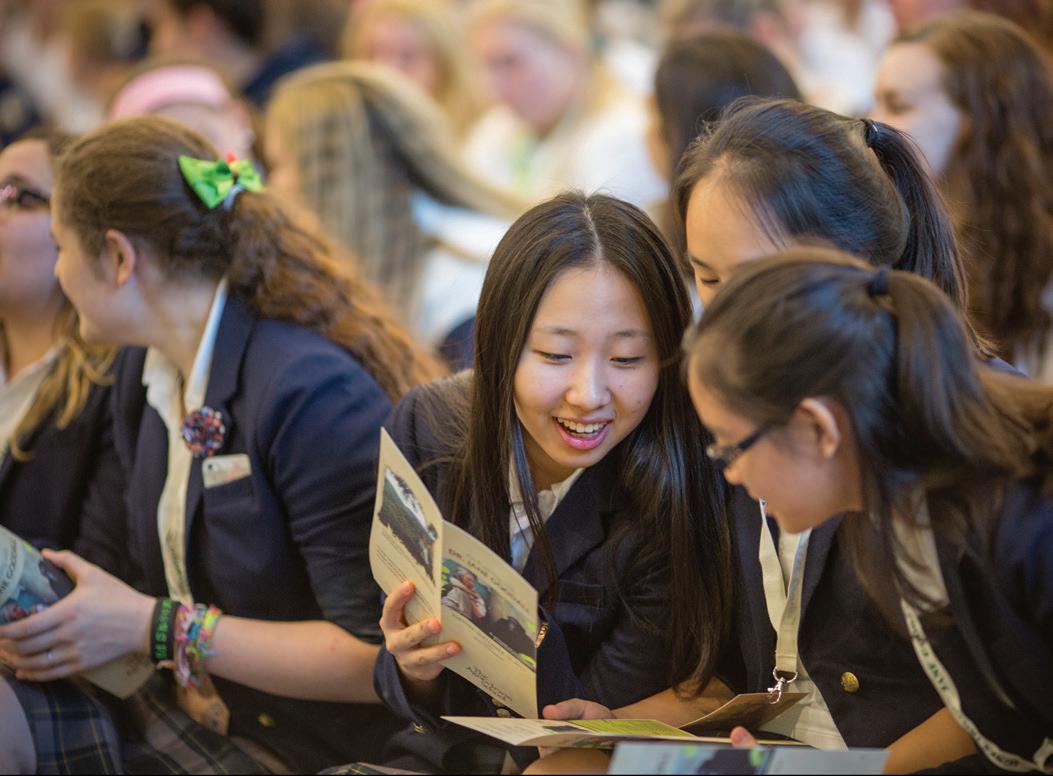
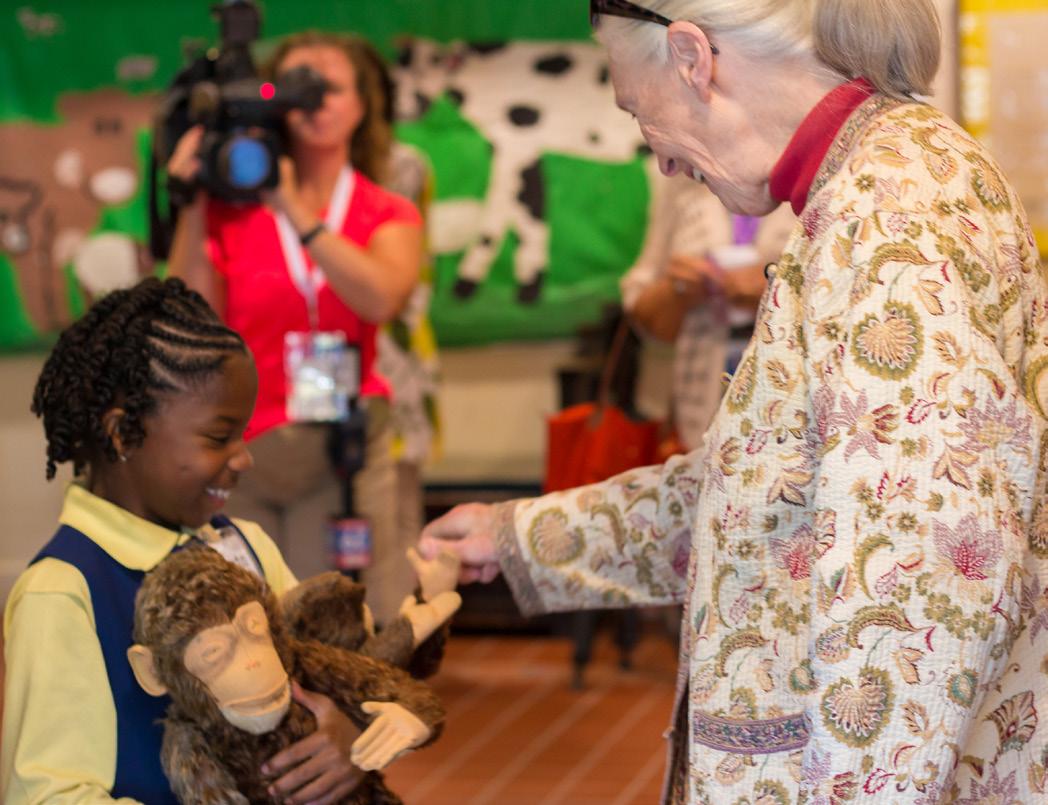
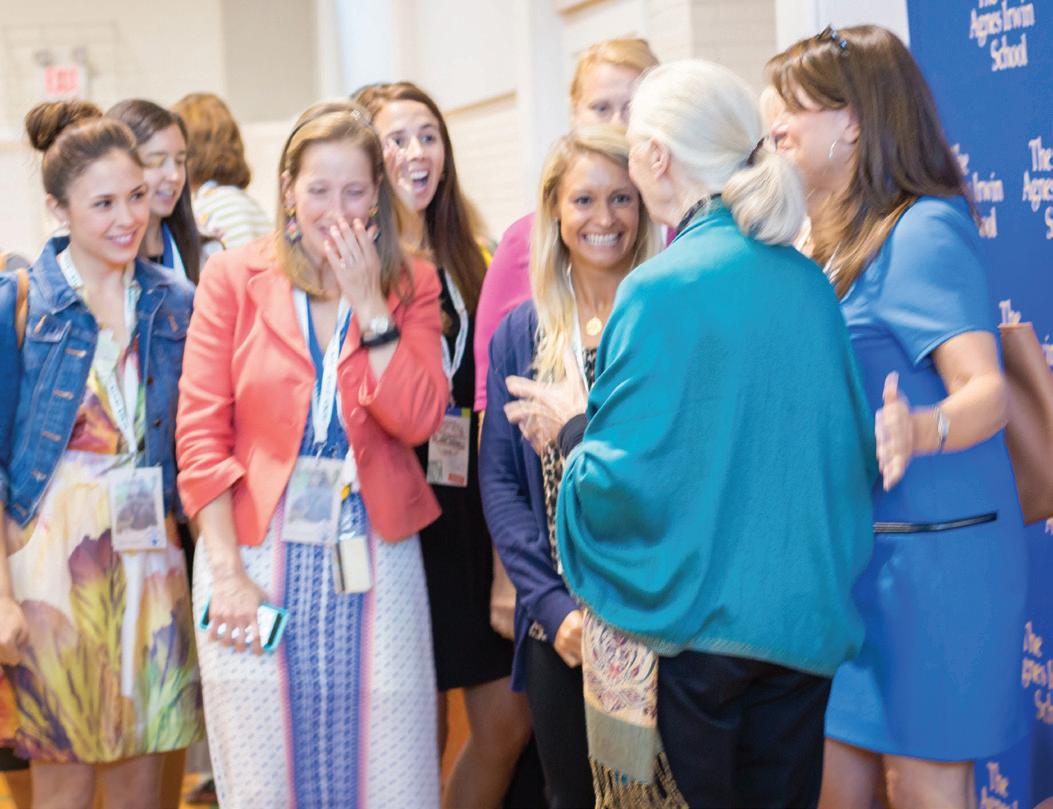
Top: Upper School students sneak a peek at the program before Goodall’s lecture. Middle: Goodall and fourth grader Dakota Puriefoy share a laugh as Goodall jokingly “meets” a stuffed chimpanzee. The researcher’s own stuffed monkey, Mr. H, always accompanies her on her lecture circuit. Bottom: Goodall greets a star-struck set of Lower School teachers at a special reception for faculty and staff.
Lower School Develops Technology Philosophy for the Future This We Believe
BY WANDA ODOM
Survey the literature on educational technology and there is no shortage of promotion and information about software, apps and devices to help students learn or learn better — their ABCs, phonetic sounds or how to solve quadratic equations.
What is less clear, according to Director of Academic Technology Julie Diana, is how best to integrate all the gizmos, bells and whistles that the digital age offers into the classroom and the curriculum, particularly in the early years.
Last summer, a group of eight Lower School teachers and administrators tried to tackle the question: What are the best practices in technology education for elementary students?
“When I look to the research literature for information about how to teach with technology in early education, I don’t find a whole lot. I want to be sure we are making decisions about technology based on what’s best for our youngest students — not based on a perception that we need to keep up with the latest innovations,” said Diana, pointing out the issue of screen time. She noted that often, young students watch a portable video player on the way to school or on the way home, or while dinner is being prepared. Educators must take into account a student’s engagement with technology when they are not in the classroom when determining what’s an appropri
ate approach. “A lot of schools have flashy things, like one-to-one iPads or MacBooks,” Diana said. “I come from a place of, ‘How much screen time do we want nine-year-olds to have in a day?’ That’s an important question to ask, and I think Lower School teachers would agree with that.”
“The teachers want to know if screen time interferes with fine motor development, and whether learning how to read on a tablet is the same thing as learning how to read in a book,” she said.
In addition, early childhood educators have to balance the question of timing when it comes to technology and classroom practice. Technology curriculums have a sequence — just like math, literacy and other core subjects. Teachers of kindergarten through second grade must consider the best age to introduce skills like keyboarding, mouse and touchpad use, and computer commands, in order to build skills so that students are ready for their first computer-based projects in third grade.
“What teachers were finding was that even with the curriculum, even with the scope and sequence, they were struggling to make sure the children were understanding that technology is a useful tool, and, at the same time, using it developmentally in a way that didn’t take over the classroom,” said Lower School Director Donna Lindner. The outcome of the group’s summer work is a seven-point technology philosophy statement (below) that broadly addresses key issues the Lower School — and really, all schools — will have to grapple with as an active participant in the tech-driven world of the 21st century. Questions such as what is working well, what should be changed, and what is the best timing for introducing and/or building on technology skills are themes addressed in this work.
Both Diana and Lindner are excited about the guiding principles that the group drafted, and view the statement as a crucial first step in making good choices about new hardware and software as technological advances continue to grow.
Lindner praised the undertaking as a great example of what the school’s professional growth grant can be at its best. “It’s a project that allows teachers to come together; they get to learn and stretch and challenge themselves; and the product then has the potential to impact their peers and bring us all up to a greater level of craft in our work.”
TECHNOLOGY PHILOSOPHY
• We believe that technology is a tool that is used to enhance a wide range of educational practices. • We believe that technology should support learning and should be intentionally integrated into all disciplines. • We believe that technology should improve and enhance research practices, cognitive processes and communication and collaboration skills. • We believe that technology will help us meet the diverse needs of individual learners. • We believe that because our students live in an evolving technological world, digital citizenship instruction must be a critical part of our curriculum. • We believe in the importance of judicious use of technology in the classroom. Recognizing the research and recommendations of leading experts in child health and development on the suggested amount of screen time, we will thoughtfully use technology in ways that are interactive and instructional. • We believe that teachers are learners too. When we demonstrate resilience and flexibility in using technology, we model lifelong learning for our students.
Exploring Sustainability and the Arts
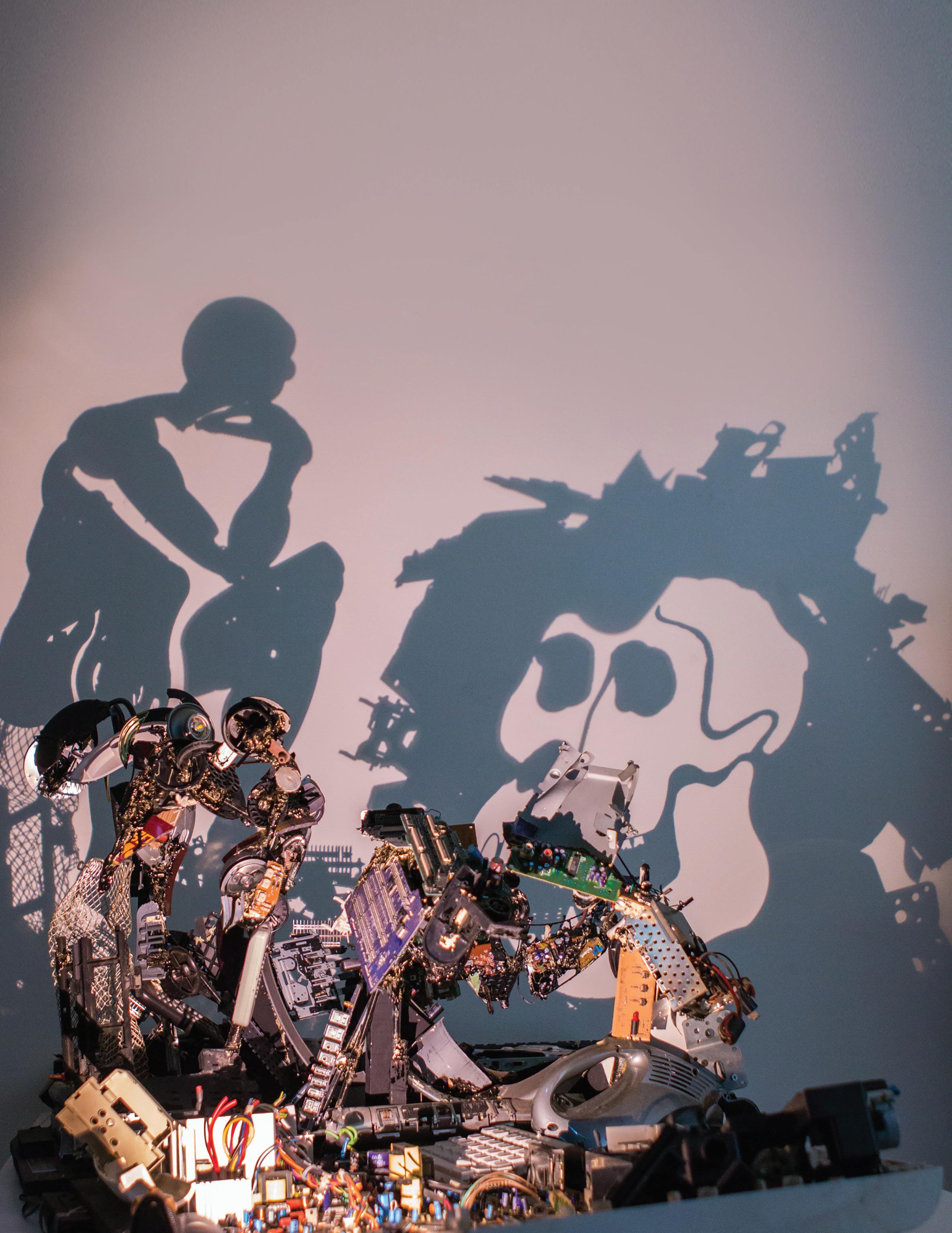
BY AMANDA MAHNKE
When a light is cast on this 220-pound pile of recycled electronic parts, a shadow of Rodin’s “The Thinker,” contemplating a gorilla skull, is cast on the wall. This is one sculpture in the series “Junk Rethunk,” which fifth graders viewed at the Philadelphia Zoo in September.
Whether in art, science, psychology or anthropology, observation is key to understanding the world around us. Dr. Jane Goodall utilized her observational skills in the journals she kept on primate behaviors in Tanzania — a practice Middle School students learned about in their summer reading. Now, in their own way, fifth graders are practicing some of those same skills through the arts.
In early October, fifth grade students took a trip to the Philadelphia Zoo, with sketchbooks in tow, to study everything from giant snakes to kangaroo rats and gorillas. Organized by art teacher Keri Farrow, the trip’s purpose was threefold: to observe animals with their own eyes and sketch them, to learn about conservation from zoo staff, and to take in “Second Nature: Junk Rethunk,” a series of art installations created from recycled materials.
Through materials as varied as spark plugs, plastic bottles and metal serving plates, the artists behind Second Nature creatively tell the stories of endangered animals. The installation includes a larger-than-life gorilla built from blue car doors, an intricate root system crafted from plastic bottles, and — a piece that was the favorite of many students — an eight-foot crocodile made entirely of chewing gum. In preparation for the trip, students were asked to choose three of the artists behind the installation, investigate their work and write three questions they might have — an exercise that is one of the students’ first forays into independent research, a thread that runs throughout the AIS Middle School years. In addition to training their brains, students also equipped themselves for the trip by training their eyes to look carefully at nature and their surroundings. In Farrow’s art class, students began the year with a unit on flowers. Armed with iPod touches, fifth graders ventured outdoors, choosing flowers, shrubbery and other natural details that interested them to photograph. Over the course of a few more classes, they drew the flowers based on those photos — and then created a “painting” using tissue paper applique.
After completion of their flower paintings, students will begin work on their own “Junk Rethunk” project — a further way of rethinking their perspective. Students will choose from Farrow’s bags of recyclables and salvaged metal pieces — water bottles, newspaper, door handles and metal serving plates — to craft their own mythical creatures. The sculptures will be inherently imperfect — and that’s okay, says Middle School Director Lynne Myavec; it’s preferable, even.
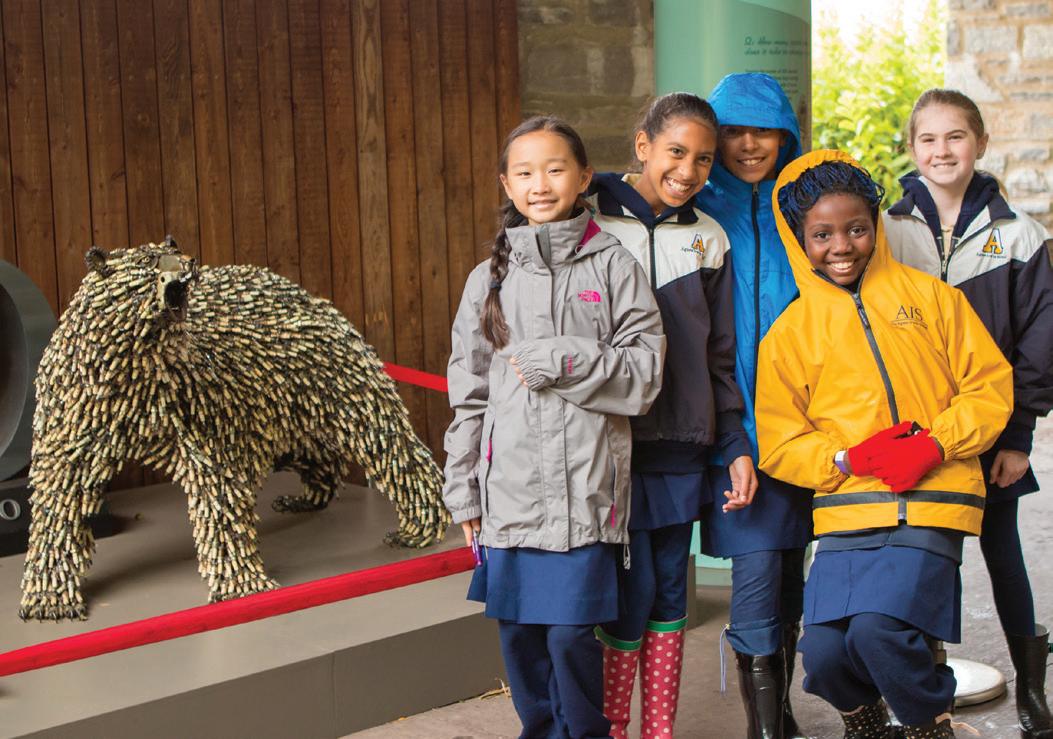
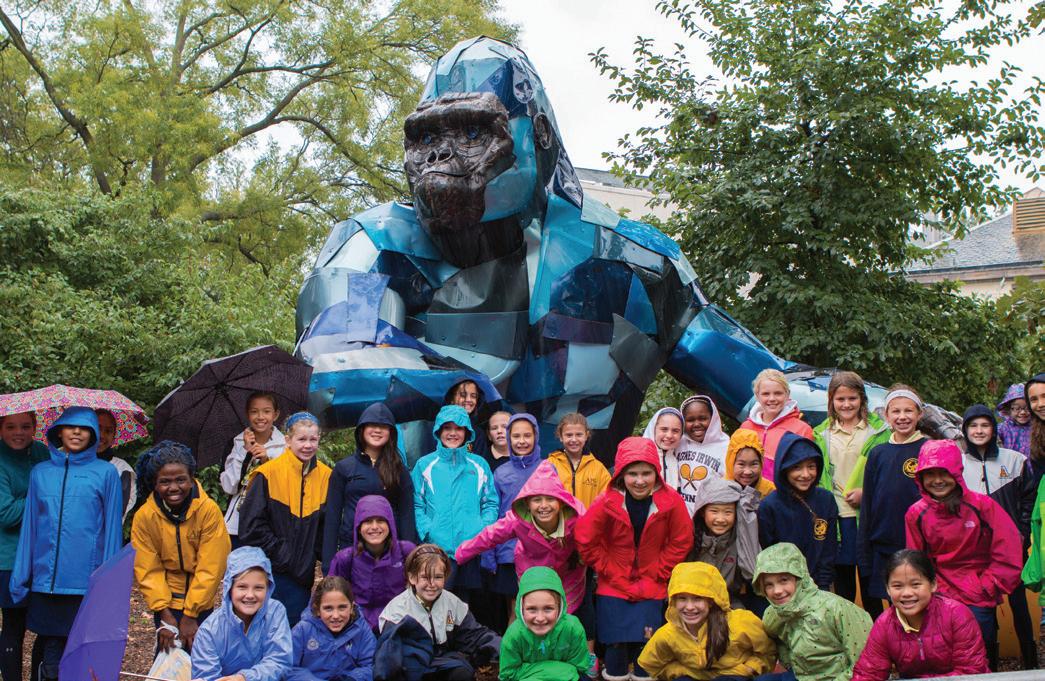
Fifth graders studied the artists behind these sculptures, all of which are made from recycled materials, before viewing them in person at The Philadelphia Zoo. The polar bear was crafted from spark plugs, and the 13-foot high, 900-pound gorilla is made of old car doors. Students created their own “junk rethunk” projects this fall.
“Perfectionism among girls is something we’re challenged with all the time,” Myavec said. “Our program provides lots of opportunities for them to take some risks, play around with materials and ideas, be creative, and try things. Working from recycled materials forces them to drop the expectation that their project must be flawless — a great exercise for middle schoolers.” It’s also a lesson the girls are learning — sometimes the hard way — in the final phase of their current art project, “painting” with tissue paper applique. “You can control a sketch, but you can’t always control tissue paper,” Farrow said. “A lot of the time, it bleeds out. The shape you cut it may not lay out perfectly — it’s not always going to be a perfect match.” Activities like this, and the Junk Rethunk project, inspire the girls to take liberties, Farrow said. “Even nature has its mutations, flaws and unique qualities; every animal and human has its own differences,” Farrow said. “There are so many different variations among us, and nature reflects that as well.”
A trip to the zoo is always fun — but connecting that fun to science, the arts, research and sustainability makes it meaningful learning, too.
Agnes Irwin Students Venture to Study Abroad Global Impact Impact Mondial Impacto Global

BY WANDA ODOM
unior Cordelia Hare always knew she wanted to study abroad during high school because of her interest in foreign languages and other cultures, and she credits her years in Agnes Irwin’s Middle and Upper School with preparing her to tackle such a pursuit after ninth grade.
“I was ready to experience a completely new and different place with an open mind, hoping to gain new perspective along with a life-changing experience,” said Hare, who returned to campus this fall after spending a year at St. Stephen’s International School in Rome.
In recent years, at least five Upper School students have spent part or all of a school year studying in Japan, Thailand, Switzerland and Rwanda, or spent a portion of the summer in educational programs abroad.
Upper School Director Joanne Hoffman said such experiences naturally result in growth and transformation for students, giving them a more expansive worldview that they can bring back to campus. Hoffman sees these opportunities as “a living embodiment of the curriculum” and an example of the school’s mission to empower girls to live a legacy.
After conducting extensive research on school in Europe, and making a connection with a former Agnes Irwin educator living abroad, Hare applied to the boarding school’s nine-month program for 10th grade.
“My education at Agnes Irwin over the years brought me up to be very independent and strong-willed,” said Hare. “The friends I have made and all the support I have received over the years are what led me to have the confidence to find and welcome the opportunity to study abroad for a year.”
Hare expected to immerse herself in the culture and customs of Italy and have a defining educational experience. Her time at St. Stephen’s did not disappoint her. “I’m much more interested in international relations and maybe going to college abroad. It taught me that there are so many places you can go to college abroad, and so many things you can do — you don’t have to stick to the status quo,” she said.
Similarly, senior Kiley Mahoney spent six weeks in Morocco the summer before her senior year, participating in an Arabic language immersion program and community service through a highly competitive program sponsored by the U.S. Department of State’s Bureau of Educational and Cultural Affairs.
Mahoney traveled to Rabat, the Moroccan capital and the country’s seventh largest city center with nearly 600,000 people, after being selected to receive a merit-based scholarship for the summer program under the National Security Language Initiative for Youth (NSLI-Y). The program enables eligible high school students and recent high school graduates to learn less commonly taught languages in summer and academic-year overseas immersion programs.
“As long as I can remember, I have had a passion for languages. I study French at Agnes Irwin and have loved every second of it, but was looking for something more,” said Mahoney, who has traveled to France, Spain and Italy. Last spring, for her independent two-week Special Studies Program, she interned in the firm Reed Smith’s Abu Dhabi and Dubai offices.
She received 20 hours a week of Arabic instruction and spent the rest of her time participating in cultural enhancement and community service activities with a dozen other NSLI-Y students in the afternoons and weekends. She lived with a family in Rabat to be fully immersed in the culture and language.
Mahoney spent the summer between her sophomore and junior years taking an Arabic language course at Georgetown University, which provided a good foundation in the language. When she arrived in Morocco, she placed in the highest of three levels on an Arabic language proficiency test.
NSLI-Y gave her the opportunity to speak both Arabic and French on a daily basis with her host family as well as others, and introduced her to Muslim culture. She made a trip to the Sahara Desert by camel and slept in a traditional Bedouin tent, the shelter of nomadic desert tribes in the Middle East.
While in Morocco, she celebrated Eid, marking the end of the sacred month of Ramadan, a period of prayer, reflection and fasting for Muslims worldwide. “I could not have been luckier with the timing of my stay so as to immerse myself in the culture during a time as extraordinary as Ramadan,” she said. J
